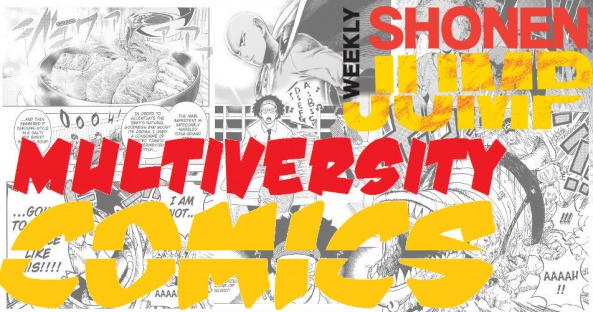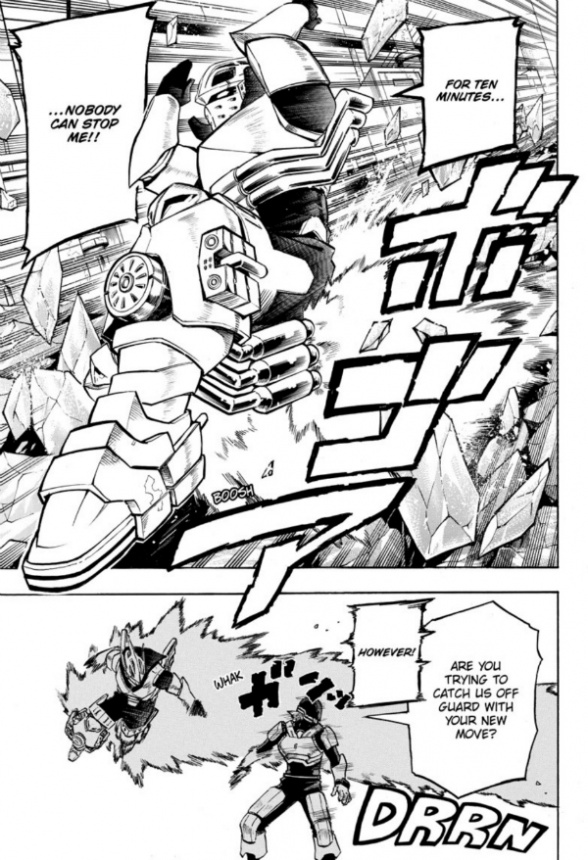
Welcome to This Week in Shonen Jump, in which a rotating duo of Multiversity staffers take a look at two stories contained in each installment of Viz Media’s Weekly Shonen Jump. For the uninitiated, Weekly Shonen Jump is an anthology that delivers more than 200 pages of manga of all varieties. We hope that you’ll join us in exploring the world of Weekly Shonen Jump each week. If you are unfamiliar, you can read sample chapters and subscribe at Viz.com.

This week, Rowan and Matt check in with “My Hero Academia” and “The Comiq.” If you have any thoughts on these titles, or “One Piece,” “Black Clover,” “Blue Exorcist,” “Dr. Stone,” “Hunter x Hunter,” “Seraph of the End,” “The Promised Neverland,” “Food Wars,” “World Trigger,” or “We Never Learn” let us know in the comments!

My Hero Academia Chapter 204
Written & Illustrated by Kohei Horikoshi
Reviewed by Matt Lune
The joint training arc continues apace in this latest chapter of “My Hero Academia,” and the best part of this whole storyline is the interesting team-ups and face-offs that the exercise between classes 1A and 1B has brought up. This installment is no exception and with the focus this time on fan-favorite Tenya Lida and an interesting revelation about his quirk.
As we see through flashback, Tenya’s family legacy has taught him a lot about his engine quirk. As his brother tells him, if he rips out the exhaust ports on his calves, new ones will regenerate that will allow him to adapt to his training. In this case, it allows him a massive boost in speed, one that makes him faster than Gran Torino, in fact, but only for 10 minutes (not to mention drastically reducing his accuracy.
He’s not the only one with a power boost though, as Tetsutetsu reveals he’s been training his steel quirk in order to negate Shoto Todoroki’s half-cold half-hot, by spending time in a blast furnace to acclimatize himself to extreme temperatures. The chapter ends with Todoroki digging deep, however, and you can’t help but think that the next chapter is going to be his time to shine.
There’s not a power upgrade in this chapter that doesn’t require personal sacrifice or pain, but that’s really the point of this whole arc. There are so many characters in “My Hero Academia” that it can be hard to develop them all while still progressing a major storyline. Here though, by having a training arc you can take the time to focus on characters and really show them push themselves in ways that will ultimately lead to greater investment in a wider range of characters.
Tenya and Todoroki steal the show in this chapter. Even if it’s Tetsutetsu that gets the drop on Todoroki fairly thoroughly, you just know that Todoroki is on his way back next chapter, and this sets that tension up nicely, leaving us on a cliffhanger before we get there. Tenya’s flashback, meanwhile, is genuinely heartwarming and shows not only how important his family and the legacy of his quirk is to him, but contrasting that with the pain he puts himself through in the present shows just how important all of this is to him.
The fight between Tetsutetsu and Todoroki gets all of the cool art in this chapter. The only double page spread is one that reveals just how much Tetsutetsu has leveled up, and as he faces the audience to announce that Todoroki’s “half ‘n’ half” doesn’t work on him, he looks genuinely scary, and ups the threat level for Todoroki to overcome next chapter.
Finally, there’s a tease of Ojiro’s potential power-up, showing him suffering from a heavy feeling in his chest. It surely won’t be long before that pays off too, but even though it doesn’t happen here, chapter 204 is thick with characters facing their limits head on. In the case of Tenya and Tetsutetsu, they surpassed their best and are now more powerful than ever. For Todoroki and Ojiro, they’re up against a brick wall now, but the seeds have been planted for them to reach new levels with their powers in upcoming chapters. Overall this is a strong and fun chapter that not only develops the characters of all involved but is filled with the promise of more development to come.
Continued belowFinal Verdict 8.2 – A solid chapter with plenty of action and character development.

The Comiq Chapter 4
Written and Illustrated by Kazuki Takahashi
Reviewed by Rowan Grover
Kazuki Takahashi’s “The Comiq” continues to run with its bizarre premise, keeping a light hearted tone and embracing the absurdity of its situation. All the character work here is pretty solid, with each member of the cast serving a role pretty well. I love Takahashi’s take on Seiya Himekawa because he blurs the line between being mega manga-ka/pop star and secret criminal really well. He handles this by being incredibly flamboyant in both roles, making it hard to see where one ends and the other begins. Ryota, the shared protagonist, is endearing in his innocence and ignorance of the happenings of the world around him, but it also makes him a little annoying that he’s so incapable of taking care of himself. Katsuo is a little more interesting here, with his character being bullied by the unlucky, laboring prison inmates, and feels a little more pitiable and sympathetic due to his situation and immense talent.
What’s interesting here is how the plot setup backfires on Ryota. Takahashi builds tension really well throughout the first half of the book with Seiya and Katsuo’s interaction. There’s a focus on visual storytelling here especially since the interaction is specifically silent, and it makes for an even more unnerving sequence. It keeps readers in the dark as to what actually might happen, making the latter sequence even more satisfying. The public finds out about Ryota’s background artist being the Halloween Murderer, and instead of having the clues in Katsuo’s art help Ryota, it backfires on him and suggests to the public that he might be criminally involved. It’s a great turnaround to keep the stakes high and put the characters in such an interesting position so early on.
Takahashi is no stranger to the art game, having worked in the industry pretty consistently for over twenty years, and this is all on display here. The general aesthetic is balanced between more old-school, cartoonish style that feels like a Tezuka call back, and more modern, typical Takahashi characters, spiky hair et al. The opening prison sequences feels like the biggest classical throwback, with a lot of the jeering bullies having big round, comically simple expressions. It’s a little jarring when comparing it to the rest of the book, but within this context it works to help us sympathize with Katsuo. This shifts pretty quickly as soon as we see Mihana running down the street to track down Ryota, returning to classic big-eyes style and becoming hyper-expressive. I like how in the midst of Mihana running, we have interludes of Ryota looking just as intense as he is so absorbed in his work, ignorant of the events occurring around him.
There’s some great sequential work on display here too. As mentioned earlier, the interaction between Katsuo and Seiya is thick with tension. What makes this work is how Takahashi splits up the panelling, forcing the reader to slow down and witness the events with the same worry that Katsuo might. The back and forth between Katsuo sweating and Seiya showing off his bizarre tie is what builds this up a lot, and even though the payoff is a little strange, using panels on a tie to depict a sequence, it’s so odd that it works in tone with the rest of the book. Later on, we get a great high octane action scene that switches between the police running to find Ryota and Ryota on the phone with the commissioner, panicking and figuring out what to do. Again, the back and forth builds tension, and is offset once more by a confusing, but visually entertaining Ryota in a bunny hat escaping on foot.
“The Comiq” is one of the stranger series in the SJ lineup. Takahashi is certainly having fun with the premise and setting, and technically it remains very solid, yet the weirdness offsets the more serious moments in a thoroughly strange way.
Final Score: 7.4 – “The Comiq” is a technical marvel, but remains one of the weirder Shonen series.






